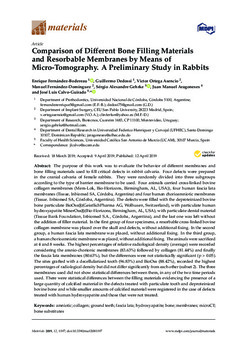| dc.contributor.author | Fernández Bodereau, Enrique | |
| dc.contributor.author | Dedossi, Guillermo | |
| dc.contributor.author | Ortega Asencio, Víctor | |
| dc.contributor.author | Fernández Domínguez, Manuel | |
| dc.contributor.author | Gehrke, Sergio Alexandre | |
| dc.contributor.author | Aragoneses, Juan Manuel | |
| dc.contributor.author | Calvo Guirado, José Luis | |
| dc.date.accessioned | 2021-08-20T14:40:11Z | |
| dc.date.available | 2021-08-20T14:40:11Z | |
| dc.date.issued | 2019 | |
| dc.identifier.citation | Fernández-Bodereau, Enrique, Guillermo Dedossi, Victor Ortega Asencio, Manuel Fernández-Domínguez, Sérgio A. Gehrke, Juan M. Aragoneses, and José L. Calvo-Guirado 2019. "Comparison of Different Bone Filling Materials and Resorbable Membranes by Means of Micro-Tomography. A Preliminary Study in Rabbits" Materials 12, no. 8: 1197. https://doi.org/10.3390/ma12081197 | es |
| dc.identifier.issn | 1996-1944 | |
| dc.identifier.other | info:eu-repo/semantics/dataset/doi/10.3390/ma12081197 | |
| dc.identifier.uri | http://hdl.handle.net/11086/19788 | |
| dc.description.abstract | The purpose of this work was to evaluate the behavior of different membranes and bone filling materials used to fill critical defects in rabbit calvaria. Four defects were prepared in the cranial calvaria of female rabbits. They were randomly divided into three subgroups according to the type of barrier membrane to be used. Four animals carried cross-linked bovine collagen membranes (Mem-Lok, Bio-Horizons, Birmingham, AL, USA)), four human fascia lata membranes (Tissue, Inbiomed SA, Córdoba, Argentina) and four human chorioamniotic membranes (Tissue. Inbiomed SA, Córdoba, Argentina). The defects were filled with the deproteinized bovine bone particulate BioOss®(GeistlichPharma AG, Wolhusen, Switzerland), with particulate human hydroxyapatite MinerOss®(Bio-Horizons, Birmingham, AL, USA), with particulate dental material (Tissue Bank Foundation, Inbiomed S.A., Córdoba, Argentina), and the last one was left without the addition of filler material. In the first group of four specimens, a resorbable cross-linked bovine collagen membrane was placed over the skull and defects, without additional fixing. In the second group, a human fascia lata membrane was placed, without additional fixing. In the third group,
a human chorioamniotic membrane was placed, without additional fixing. The animals were sacrificed at 4 and 8 weeks. The highest percentages of relative radiological density (average) were recorded considering the amnio-chorionic membranes (83.63%) followed by collagen (81.44%) and finally the fascia lata membranes (80.63%), but the differences were not statistically significant (p > 0.05). The sites grafted with a decellularized tooth (96.83%) and BioOss (88.42%), recorded the highest percentages of radiological density but did not differ significantly from each other (subset 2). The three membranes used did not show statistical differences between them, in any of the two time periods used. There were statistical differences between the filling materials evidencing the presence of a large quantity of calcified material in the defects treated with particulate tooth and deproteinized bovine bone and while smaller amounts of calcified material were registered in the case of defects treated with human hydroxyapatite and those that were not treated. | es |
| dc.language.iso | eng | es |
| dc.rights | Atribución-NoComercial-CompartirIgual 4.0 Internacional | * |
| dc.rights.uri | http://creativecommons.org/licenses/by-nc-sa/4.0/ | * |
| dc.subject | Amniotic | es |
| dc.subject | Collagen | es |
| dc.subject | Ground teeth | es |
| dc.subject | Fascia lata | es |
| dc.subject | Hydroxyapatite | es |
| dc.subject | Bone | es |
| dc.subject | Membranes | es |
| dc.subject | MicroCT | es |
| dc.subject | Bone substitutes | es |
| dc.title | Comparison of Different Bone Filling Materials and Resorbable Membranes by Means of Micro-Tomography. A Preliminary Study in Rabbits | es |
| dc.type | article | es |
| dc.description.version | publishedVersion | es |
| dc.description.fil | Fil: Fernández Bodereau, Enrique. Universidad Nacional de Córdoba. Facultad de Odontología. Departamento de Prostodoncia; Argentina. | es |
| dc.description.fil | Fil: Dedossi, Guillermo. Universidad Nacional de Córdoba. Facultad de Odontología. Departamento de Prostodoncia; Argentina. | es |
| dc.description.fil | Fil: Ortega Asencio, Víctor. Universidad CEU San Pablo; España. | es |
| dc.description.fil | Fil: Fernández Domínguez, Manuel. Universidad CEU San Pablo; España. | es |
| dc.description.fil | Fil: Gehrke, Sergio Alexandre. Biotecnos. Departamento de Investigación; Uruguay. | es |
| dc.description.fil | Fil: Aragoneses, Juan Manuel. Universidad Federico Henriquez y Carvajal. Departamento de Investigación Dental; República Dominicana. | es |
| dc.description.fil | Fil: Calvo Guirado, José Luis. Universidad Católica San Antonio de Murcia. Facultad de Ciencias de la Salud; España. | es |
| dc.journal.city | Basel | es |
| dc.journal.country | Suiza | es |
| dc.journal.editorial | MDPI | es |
| dc.journal.number | 8 | es |
| dc.journal.pagination | 2 - 19 | es |
| dc.journal.title | Materials | es |
| dc.journal.volume | 12 | es |





